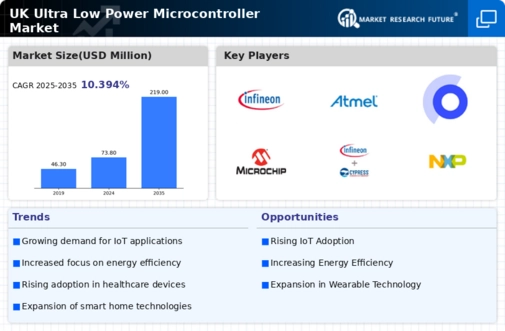Growing Adoption of IoT Devices
The increasing proliferation of Internet of Things (IoT) devices in the UK is a primary driver for the ultra low-power-microcontroller market. As more devices become interconnected, the demand for energy-efficient microcontrollers rises. In 2025, it is estimated that the number of IoT devices in the UK will exceed 1 billion, necessitating the use of ultra low-power microcontrollers to ensure prolonged battery life and reduced energy consumption. This trend is particularly evident in sectors such as smart home technology and industrial automation, where low power consumption is critical. Thus, the ultra low-power-microcontroller market is positioned to benefit significantly from this growing adoption, as manufacturers seek to enhance device performance while minimizing energy usage.
Emergence of Wearable Technology
The rise of wearable technology in the UK is significantly impacting the ultra low-power-microcontroller market. Wearable devices, such as fitness trackers and smartwatches, require microcontrollers that can operate efficiently while consuming minimal power. The market for wearables is projected to reach £2 billion by 2025, creating substantial opportunities for ultra low-power microcontroller manufacturers. These devices often rely on battery life as a key selling point, making energy efficiency a critical factor. As consumer interest in health and fitness continues to grow, the ultra low-power-microcontroller market is likely to expand in tandem, driven by the need for innovative and energy-efficient solutions in wearable technology.
Increased Focus on Sustainability
The heightened awareness of environmental sustainability in the UK is propelling the ultra low-power-microcontroller market. As businesses and consumers alike prioritize eco-friendly solutions, the demand for energy-efficient microcontrollers is likely to surge. In 2025, it is anticipated that the market for sustainable electronics will grow by 20%, with ultra low-power microcontrollers playing a pivotal role in reducing carbon footprints. This shift towards sustainability is not only driven by consumer preferences but also by regulatory pressures aimed at reducing energy consumption across various sectors. Consequently, The ultra low-power-microcontroller market is expected to thrive as companies align their products with sustainability goals.
Advancements in Wireless Communication
The rapid advancements in wireless communication technologies, such as 5G, are influencing the ultra low-power-microcontroller market in the UK. These technologies require microcontrollers that can operate efficiently with minimal power consumption while maintaining high performance. The demand for ultra low-power microcontrollers is expected to grow as industries adopt 5G for applications like smart cities and autonomous vehicles. In 2025, the UK is projected to invest over £1 billion in 5G infrastructure, further driving the need for energy-efficient solutions. This trend indicates a strong correlation between the evolution of communication technologies and the growth of the ultra low-power-microcontroller market, as manufacturers strive to meet the requirements of next-generation applications.
Rising Demand in Automotive Applications
The automotive sector in the UK is increasingly adopting ultra low-power microcontrollers, driven by the need for enhanced vehicle efficiency and performance. With the shift towards electric vehicles (EVs) and advanced driver-assistance systems (ADAS), the demand for energy-efficient microcontrollers is expected to rise. In 2025, the UK automotive market is projected to invest over £3 billion in EV technology, which will likely boost the ultra low-power-microcontroller market. These microcontrollers are essential for managing various vehicle functions while minimizing energy consumption. As the automotive industry continues to evolve, The ultra low-power-microcontroller market is poised to benefit from the growing demand for innovative and efficient solutions in the automotive sector.
























Leave a Comment